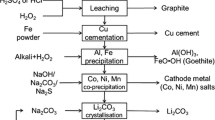Abstract
Lithium-ion batteries have high energy efficiency and good cycling life and are considered as one of the best energy storage device for hybrid and/or electrical vehicle. Still, several problems must be solved prior to a broad adoption by the automotive industry: energy density, safety, and costs. To enhance both energy density and safety, the current study aims at depositing binder-free cathode materials using inductively coupled thermal plasma. In a first step, lithium iron phosphate (LiFePO4) powders are synthesized in an inductively coupled thermal plasma reactor and dispersed in a conventional polyvinylidene fluoride (PVDF) binder. Then, binder-free LiFePO4 coatings are directly deposited onto nickel current collectors by solution precursor plasma spraying (SPPS). The morphology, microstructure, and composition of the synthesized LiFePO4 powders and coatings are fully characterized by electronic microscopy, x-ray diffraction, and x-ray photoelectron spectroscopy (XPS). Quantifying Li with XPS requires the substitution of iron with manganese in the SPPS precursors (LiMPO4, where M = Fe or Mn). The plasma-derived cathodes (with and without PVDF binder) are assembled in button cells and tested. Under optimized plasma conditions, cyclic voltammetry shows that the electrochemical reversibility of plasma-derived cathodes is improved over that of conventional sol-gel-derived LiFePO4 cathodes.









Similar content being viewed by others
References
Y. Abu-Lebdeh et al., Nanostructure Science and Technology, Nanotechnology for Lithium-Ion Batteries, D.J. Lockwood, Ed., Springer, New York, 2013, p 282
B.L. Ellis et al., Positive Electrode Materials for Li-Ion and Li-Batteries, Chem. Mater., 2010, 22(3), p 691-714
M.V. Reddy et al., Metal Oxides and Oxysalts as Anode Materials for Li Ion Batteries, Chem. Rev., 2013, 113(7), p 5364-5457
B. Scrosati et al., Lithium Batteries: Status, Prospects and Future, J. Power Sources, 2010, 195(9), p 2419-2430
M. Armand et al., Building Better Batteries, Nature, 2008, 451(7179), p 652-657
W. Peng et al., A Novel Sol–Gel Method Based on FePO4 2H2O to Synthesize Submicrometer Structured LiFePO4/C Cathode Material, J. Power Sources, 2011, 196(5), p 2841-2847
W.-J. Zhang, Structure and Performance of LiFePO4 Cathode Materials: A Review, J. Power Sources, 2011, 196(6), p 2962-2970
D. Jugović et al., A Review of Recent Developments in the Synthesis Procedures of Lithium Iron Phosphate Powders, J. Power Sources, 2009, 190(2), p 538-544
J. Guo et al., Development of Nanopowder Synthesis Using Induction Plasma, Plasma Sci. Technol., 2010, 12(2), p 188-199
P.L. Fauchais et al., Thermal Spray Fundamentals: From Powder to Part, Springer, New York, 2014, p 1566
T. Suetsuna et al., Synthesis of Self-Forming Core/Shell Nanoparticles of Magnetic Metal/Nonmagnetic Oxide, Acta Mater., 2014, 78, p 320-327
P. Fauchais et al., Parameters Controlling Liquid Plasma Spraying: Solutions, Sols, or Suspensions, J. Therm. Spray Technol., 2008, 17(1), p 31-59
A. Killinger et al., Review of New Developments in Suspension and Solution Precursor Thermal Spray Processes, J. Therm. Spray Technol., 2011, 20(4), p 677-695
C. Muoto et al., Identification of Desirable Precursor Properties for Solution Precursor Plasma Spray, J. Therm. Spray Technol., 2011, 20(4), p 802-816
É. Darthout et al., Lu2O3-SiO2-ZrO2 Coatings for Environmental Barrier Application by Solution Precursor Plasma Spraying and Influence of Precursor Chemistry, J. Therm. Spray Technol., 2014, 23(3), p 325-332
P.S. Mohanty, In-Situ Plasma Synthesis and Deposition Platform for Energy Storage Devices, Adv. Mater. Process., 2011, 169(11), p 63-64
N. Pentyala et al., Binder Free Porous Ultrafine/Nano Structured LiCoO2 Cathode from Plasma Deposited Cobalt, Electrochim. Acta, 2011, 56(27), p 9851-9859
V. Varadaraajan et al., Direct Synthesis of Nanostructured V2O5 Films Using Solution Plasma Spray Approach for Lithium Battery Applications, J. Power Sources, 2011, 196(24), p 10704-10711
P.S. Mohanty et al., Direct Thermal Spray Synthesis of Li Ion Battery Components, U.S. Patent Application 12/855,789, 13, Aug 2010.
R. Tummala et al., Binder Free, Porous and Nanostructured Co3O4 Anode for Li-Ion Batteries from Solution Precursor Plasma Deposition, J. Power Sources, 2012, 199, p 270-277
P. Lamontagne et al., Synthesis of Silicon Nanowires from Carbothermic Reduction of Silica Fume in RF Thermal Plasma, Phys. Status Solidi A, 2014, 211(7), p 1610-1616
F. Quesnel et al., “Synthesis of Lithium Titanates Nanoparticles in an Inductive Plasma Reactor,” OREBA 1.0. Montreal, QC, Canada, 2014.
Y.-H. Rho et al., Surface Chemistry of LiFePO4 Studied by Mössbauer and X-Ray Photoelectron Spectroscopy and Its Effect on Electrochemical Properties, J. Electrochem. Soc., 2007, 154(4), p A283-A289
K. Saravanan et al., Storage Performance of LiFePO4 Nanoplates, J. Mater. Chem., 2009, 19(5), p 605-610
L. Castro et al., Aging Mechanisms of LiFePO4//Graphite Cells Studied by XPS: Redox Reaction and Electrode/Electrolyte Interfaces, J. Electrochem. Soc., 2012, 159(4), p A357-A363
P.P. Prosini et al., Determination of the Chemical Diffusion Coefficient of Lithium in LiFePO4, Solid State Ionics, 2002, 148(1-2), p 45-51
A.V. Churikov et al., Determination of Lithium Diffusion Coefficient in LiFePO4 Electrode by Galvanostatic and Potentiostatic Intermittent Titration Techniques, Electrochim. Acta, 2010, 55(8), p 2939-2950
Acknowledgments
The financial support by the Natural Sciences and Engineering Research Council of Canada (NSERC RGPIN-2014-05928) and the Université de Sherbrooke is gratefully acknowledged. The authors also appreciate the helpful technical support of Kossi Béré, Charles Bertrand, and Sonia Blais, as well as fruitful discussions with Professor François Gitzhofer.
Author information
Authors and Affiliations
Corresponding author
Additional information
This article is an invited paper selected from presentations at the 2015 International Thermal Spray Conference, held on May 11-14, 2015, in Long Beach, California, USA, and has been expanded from the original presentation.
Rights and permissions
About this article
Cite this article
Major, K., Veilleux, J. & Brisard, G. Lithium Iron Phosphate Powders and Coatings Obtained by Means of Inductively Coupled Thermal Plasma. J Therm Spray Tech 25, 357–364 (2016). https://doi.org/10.1007/s11666-015-0289-0
Received:
Revised:
Published:
Issue Date:
DOI: https://doi.org/10.1007/s11666-015-0289-0




